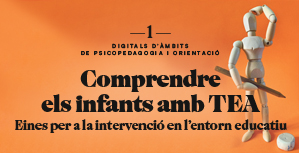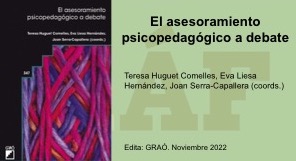Proposal of a tool for evaluating theory of mind in children
DOI:
https://doi.org/10.32093/ambits.vi51.1417Keywords:
Theory of mind, Children, Evaluation, ToolAbstract
Theory of mind (ToM) is the human capacity to understand people’s mental states, which allows us to understand and anticipate their behaviour, and therefore has important implications for their socialization. Although there are currently some tools to evaluate this capability, none of them considers the evolution of its main developmental milestones from the most basic to the most advanced. That’s why we designed the ToM Assessment Instrument (IATM), a tool consisting of 17 tasks based on the existing scientific literature, which has been designed to help psychologists to detect those aspects of ToM with which children aged between 3 and 12 years may experience difficulties. Therefore, it is an instrument for the detection social understanding difficulties that aims to contribute to the design of educational interventions adjusted to the specific difficulties of children.
References
Baron-Cohen, S. (2000). Theory of mind and autism: A review. International Review of Research in Mental Retardation, 23, 169-184.
Björklund, D.F. (2011). Children’s Thinking. Cognitive Development and Individual Differences. Belmont: Wadsworth, Cengage Learning.
Burnel, M., Perrone-Bertolotti, M., Reboul, A., Baciu, M., iDurrleman, S. (2018). Reducing the language content in ToM tests: A developmental scale. Developmental psychology, 54(2), 293.
Carpendale, J., i Lewis, C. (2006). How children develop social understanding. Blackwell Publishing.
Devine, R. T., i Hughes, C. (2014). Relations between false belief understanding and executive function in early childhood: A meta‐analysis. Child Development, 85, 1777-1794.
Doherty, M. J. (2009). Theory of Mind: How Children Understand Others’ Thoughts and Feelings. USA i Canadà: Psychology Press.
Feinfield, K. A., Lee, P. P., Flavell, E. R., Green, F. L., i Flavell, J. H. (1999). Young children's understanding of intention. Cognitive Development,
14(3), 463-486.
Hickling, A. K., Wellman, H. M., i Gottfried, G. M. (1997). Preschoolers' understanding of others' mental attitudes towards pretend happenings.
British Journal of Developmental Psychology, 15(3), 339-354.
Hiller, R. M., Weber, N., i Young, R. L. (2014). The validity and scalability of the Theory of Mind Scalewith toddlers and preschoolers. Psychological assessment, 26(4), 1388.
Nilsson, K. K., i de Lopez, K. J. (2016). Theory of mind in children with specific language impairment: A systematic review and meta‐analysis. Child Development, 87(1), 143-153.
O’Hare, A. E., Bremner, L., Nash, M., Happé, F., i Pettigrew, L. M. (2009).A clinical assessment tool for advanced theory of mind performance in 5
to 12 year olds. Journal of Autism and Developmental Disorders, 39(6), 916-928.
Osterhaus, C., Koerber, S., i Sodian, B. (2016).Scaling of advanced theory-of-mind tasks. Child Development, 87(6), 1971–1991.
Peterson, C. C., Wellman, H. M., i Liu, D. (2005). Steps in theory‐of‐mind development for children with deafness or autism. Child development, 76(2), 502-517.
Pons, F. i Harris, P. (2000).Test of Emotion Comprehension – TEC. Oxford: University of Oxford.
Pons, F., Harris, P. L., i de Rosnay, M. (2004). Emotion comprehension between 3 and 11 years: Developmental periods and hierarchical organization. European Journal of Developmental Psychology, 1(2), 127-152.
Pujals, E., Batlle, S., Camprodon, E., Pujals, S., Estrada, X., Aceña, M.,i Pérez-Solá, V. (2016). Brief report: Translation and adaptation of the theory of mind inventory to Spanish. Journal of Autism and Developmental Disorders, 46(2), 685-690.
Sidera, F., Amadó, A., i Serrat, E. (2013). Are you really happy? Children’s understanding of real vs. pretend emotions. Current Psychology, 32(1), 18-31.
Sidera, F., Amadó, A., i Martínez, L. (2017). Influences on facial emotion recognition in deaf children. The Journal of Deaf Studies and Deaf Education, 22(2), 164-177.
Sidera, F., Serrat, E., Rostan, C., iSanz-Torrent, M. (2011). Do children realize that pretend emotions might be unreal? The Journal of Genetic Psychology, 172(1), 40-55.
Slaughter, V., Imuta, K., Peterson, C. C., i Henry, J. D. (2015). Meta-analysis of theory of mind and peer popularity in the preschool and early school years. Child Development, 86(4), 1159–1174.
Sutton, J., Smith, P., i Swettenham, J. (1999). Social cognition and bullying: Social inadequacy or skilled manipulation? British Journal of Developmental Psychology, 17, 435 – 450.
Sullivan, K., Zaitchik, D., i Tager-Flusberg, H. (1994). Preschoolers can attribute second-order beliefs. Developmental Psychology, 30(3), 395.
Talwar, V., i Lee, K. (2008). Social and cognitive correlates of children’s lying behaviour. Child development, 79(4), 866-881.
Tomasello, M. (2000). The social-pragmatic theory of word learning. Pragmatics. Quarterly Publication of the International Pragmatics Association (IPrA), 10(4), 401-413.
Walle, E. A., i Campos, J. J. (2014). The development of infant detection of inauthentic emotion. Emotion, 14(3), 488.
Wellman, H. M., Cross, D., i Watson, J. (2001). Meta‐analysis of theory‐of‐mind development: The truth about false belief. Child development, 72(3), 655-684.
Wellman, H. M., i Liu, D. (2004). Scaling of theory‐of‐mind tasks. Child development, 75(2), 523-541.
Wellman, H.M. (2014). How Theory of Mind Develops. Oxford: University Press
Wellman, H.M. (2016). Cognición social y educación: teoría de la mente. Pensamiento Educativo. Revista de Investigación Educacional Latinoamericana, 53(1), 1-23
Westby, C i Robinson, L. (2014). A developmental perspective for promoting theory of mind. Topics in Language Disorders, 34(3), 362-382.

Downloads
Published
Issue
Section
License
The authors maintain their copyright and give the right to the first publication of the work to the journal, registered under a Creative Commons Attribution-Non Commercial-NoDerivs license. This license allows others to download the works and to share them with others as long as they credit the author, but it does not allow for any kind of modification or commercial use.














